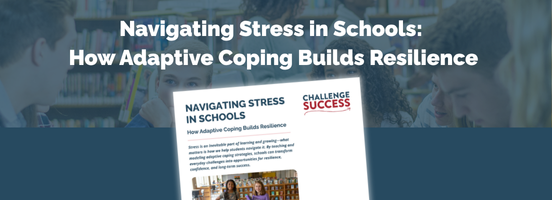
By The Challenge Success Team
The elementary years are rich with opportunities to establish a love of learning, support social-emotional growth, and form trusting relationships with peers and adults alike.
When we build protective factors early in students’ lives—such as connection, agency, and a sense of purpose—we help them understand what they need in order to thrive as engaged learners. These early investments pay dividends, preparing students for the challenges of adolescence, secondary school, and adulthood–not just academically, but socially and emotionally as well.
So where can schools start? Here are three ways to plant the seeds of engagement that grow into a love of learning, motivation, and curiosity.
Leverage Curiosity to Drive Engagement

Elementary school is a critical time for cognitive and emotional development. The natural curiosity children bring to school presents an ideal opportunity to build the foundations of academic engagement and future success. At this stage, students are not only developing essential math and literacy skills, but also forming the academic habits and mindsets that will guide them for years to come.
Research confirms that early engagement plays a key role in long-term outcomes, including academic achievement and school completion (Rosário et al., 2016; Fredricks et al., 2004). When students are engaged—interested, involved, and invested—they are more likely to perform well and retain what they learn. Conversely, low engagement in the early years can hinder students from reaching their full potential (Bodovski & Farkas, 2007).
Encourage Self-Directed Learning

One powerful way to foster student engagement is through self-directed learning—providing opportunities for students to explore their interests, set personal goals, and make choices about how they learn best. These experiences not only cultivate intrinsic motivation but also strengthen students’ connection to the learning process. As they take greater responsibility for their learning, students begin to develop a strong sense of agency and ownership that can last well beyond the classroom.
Here are a few strategies schools can use to promote self-direction in developmentally appropriate ways:
- Use choice boards or learning menus to give students options in how they demonstrate understanding.
- Example: For a science unit on weather, students might choose to create a poster, write a weather report, or build a simple experiment.
- Incorporate inquiry-based activities that allow students to explore real-world problems or questions.
- Example: A class curious about energy use at school could research ways to reduce electricity consumption and present their findings to the principal.
- Introduce Passion Projects, giving students time each week to explore a topic of personal interest.
- Example: A student passionate about animals might research endangered species and create an awareness campaign.
- Support student goal setting and reflection to build metacognition and ownership of learning.
- Example: Students might track weekly goals in a personal journal, then share a highlight of their progress during morning meetings.
These practices develop important skills like curiosity, perseverance, and independence—key components of lifelong learning.
Promote Autonomy and Voice

Alongside self-direction, students also benefit from consistent opportunities to exercise autonomy and have their voices heard in everyday classroom decisions. When students feel their opinions matter and have real influence, they are more likely to show up fully–as a learner and as members of the school community.
Promoting autonomy doesn’t require a major overhaul. Simple, intentional practices can make a difference:
- Co-create classroom agreements or routines to build shared ownership of the learning environment.
- Allow flexible formats for projects, such as art, video, or storytelling, to let students express their learning authentically.
- Use self-assessments alongside grades to support reflection and personal growth.
- Invite student input in shaping class activities or choosing books to build a sense of belonging and agency.
By weaving “voice and choice” into classroom experiences, educators create more inclusive and empowering learning spaces.
Interested in bringing these practices to your school?
Engagement is just one of the protective factors that can be nurtured early on to support whole-child development. When schools invest in these foundations during the elementary years, students are more prepared to navigate the complexities of adolescence with resilience, confidence, and connection.
The Challenge Success Elementary School Partnership offers tools, strategies, and coaching to help school communities build healthy, balanced, and engaged learning environments from the ground up. Well-being, engagement, and belonging don’t just improve on their own–they grow from intentional design.
Explore the Elementary School Partnership to learn how your school can get started.
Challenge Success, a nonprofit affiliated with the Stanford Graduate School of Education – elevates student voice and implements research-based, equity-centered strategies to increase well-being, engagement, and belonging in K-12 schools.
